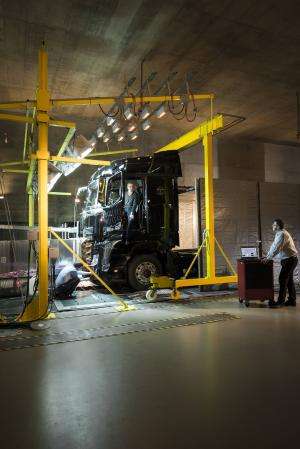Efficient operation of commercial vehicle air conditioning systems

Truck drivers are at the wheel for up to ten hours a day. A comfortable climate in the driver's cab is of decisive importance to the driver's performance and driving safety. However, air conditioning systems may increase fuel consumption by up to ten percent depending on the type of vehicle, the type of air conditioning system, and the operation conditions. Scientists of Karlsruhe Institute of Technology (KIT) therefore develop more efficient operation strategies. To test these strategies under realistic conditions with a reasonable time and cost expenditure, they designed a new test rig.
"Most car drivers know that switching on the air conditioning system makes the engine run more slowly, the car becomes less sportive," says Michael Frey of the Institute of Vehicle System Technology (FAST) of KIT. By means of a smart control, the energy released while a car coasts to a stop might be used to operate the air conditioning system at increased power. When the car starts up, by contrast, it would be more efficient to throttle the air conditioning system and to supply the engine with full energy. To optimize the interaction of vehicle, air conditioning system, and environmental factors, the researchers developed a new test rig. Here, test series of several weeks duration can be carried out at low costs.
Actual energy consumption of an air conditioning system cannot be determined separately: "Its efficiency among others depends on the driving mode of the vehicle and the surrounding climate conditions, such as solar irradiation, air temperature, and air humidity," Frey says. In humid tropical climate zones, the air conditioning system has to work much harder than, for example, in moderate Scandinavia. In addition, the size of the driver's cab and the utilization scheme of commercial vehicles play an important role. Parcel services use vans, the doors of which are opened and closed repeatedly. In long-distance traffic, the engine is operated continuously over longer terms. The new test rig for air conditioning systems models the conditions on the road as realistically as possible, while minimizing the technical expenditure and energy consumption. "The temperature in the driver's cab is influenced mainly by the climatic parameters of the air flowing into the cabin, by the heating of the roof, and solar irradiation through the windows," Michael Fritz explains, who developed the new test rig as part of his doctoral thesis at FAST. Hence, it is sufficient to arrange special spotlights simulating the spectrum of sunlight around the driver's cabin only and not around the complete truck.
The test rig for air conditioning systems is based on a four-wheel roller dynamometer: The truck stands on four separately driven rollers that realistically simulate the forces acting on the truck during different driving situations. "Then, we switch on several air ducts. They blow the desired air-conditioned wind towards all relevant truck parts," Fritz says. "Temperature, humidity, and the air flow rate can be adapted." The sunlight falling through the cabin windows of a truck is simulated by six spotlights. To heat up the cabin roof, the researchers use cheaper infrared light.
With such a test rig, air conditioning systems can be tested more quickly and at much lower costs than on the road or in a climatic wind tunnel. "Contrary to a road test, the driver's cab can be exposed to any weather-dependent and geographical conditions," Fritz explains. This can also be done in climatic wind tunnels, but they are designed for tests of the complete vehicle and, hence, require up to ten times more spotlights and much larger blowers. The energy and personnel costs are accordingly high. The new test rig of FAST concentrates on the driver's cab, as a result of which the costs can be reduced considerably.
Provided by Karlsruhe Institute of Technology




















